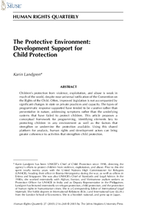WHAT: A paper introducing the concept of a ‘Protective Environment’ which outlines the elements required in a society for the effective protection of children from violence, exploitation and abuse. The eight elements key to protective environments are:
1) Government commitment and capacity;
2) Legislation and enforcement;
3) Culture and customs;
4) Open discussion;
5) Children’s life skills, knowledge and participation;
6) Capacity of families and communities;
7) Essential services; and
8) Monitoring, reporting and oversight.
The Protective Environment has been adopted by UNICEF and is key to their child protection philosophy and strategy.
WHO: Policy makers, and human rights and development practitioners involved in child protection.
WHERE: Global relevance.
WHY: A useful explanation of the broad range of actions required to prevent and respond to all forms of violence against children. It presents the case for creating a common child protection platform nationally, within and across agencies.

